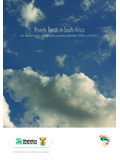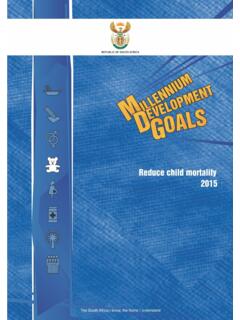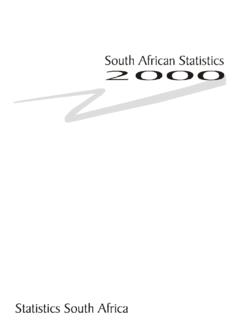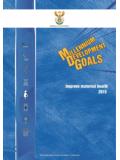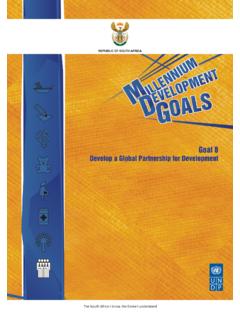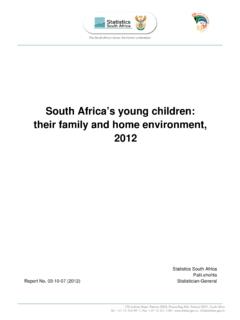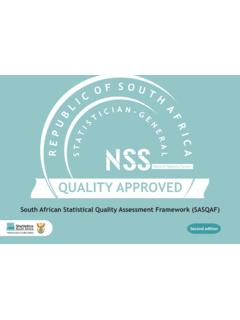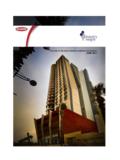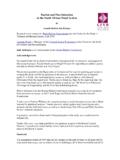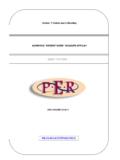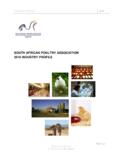Transcription of South African Statistical - Statistics South Africa
1 South African Statistical Quality Assessment Framework (SASQAF) Operational Standards and Guidelines First edition Statistics South Africa 2010 Pali Lehohla Statistician-General Published by Statistics South Africa , Private Bag X44, Pretoria, 0001 Website address: Email: Statistics South Africa , 2010 Users may apply or process this data, provided Statistics South Africa (Stats SA) is acknowledged as the original source of the data; that it is specified that the application and/or analysis is the result of the user's independent processing of the data; and that neither the basic data nor any reprocessed version or application thereof may be sold or offered for sale in any form whatsoever without prior permission from Stats SA.
2 Statistics South Africa Library Cataloguing-in-Publication (CIP) Data South African Statistical Quality Assessment Framework (SASQAF) Operational Standards and Guidelines. 1st ed. / Statistics South Africa Pretoria: Statistics South Africa , 2010 v, ISBN 978-0-621-39104-6 1. Statistics - Data quality 2. Data Quality - Assessment. 3. Assessment-Standards 4. Standards - Guidelines I. South Africa . Statistics South Africa . II. Title. (LCSH 24) A complete set of Stats SA publications is available at the Stats SA Library and the following libraries: National Library of South Africa , Pretoria Division National Library of South Africa , Cape Town Division Library of Parliament, Cape Town Bloemfontein Public Library Natal Society Library, Pietermaritzburg Johannesburg Public Library Eastern Cape Library Services, King William's Town Central Regional Library, Polokwane Central Reference Library, Nelspruit Central Reference Collection, Kimberley Central Reference Library, Mmabatho Enquires regarding the content of this book: Email.
3 Preface This publication, SASQAF Operational Standards and Guidelines, is a companion to the South African Statistical Quality Assessment Framework (SASQAF), the framework for assessment of quality of Statistics intended for public consumption in South Africa . When SASQAF was first released in 2008, we noted an increased stakeholder interest in data quality, in data quality assessment tools, and in its use among users and producers of Statistics . The interest has been stimulated by mounting pressure on heads of government departments to manage for results, especially delivery of services. Accordingly departments have established programmes for the effective monitoring and evaluation of principally their outputs and to a lesser extent outcomes and impacts.
4 A main concern of government and other stakeholders is the unknown and oftentimes poor quality of the data used to populate indicators that feed the planning and performance assessment processes in all three spheres of government. To counter the lack of small area Statistics , municipalities often have to run surveys by hiring service providers to provide the required data, which also turn out to be of unknown quality and incomparable with existing data. It is thus imperative that data collection is designed and developed to meet certain quality standards specified and known to all users and producers of the data. Evaluation of these data must shed light on their quality. SASQAF provides clear criteria and transparent procedures for evaluation of official Statistics and other data, but can also be used by data producers for self-assessment of their own products.
5 In addition, the framework can be used in outlining the terms of reference for the production of Statistics by those who rely on service providers for collection of their data. The imperative for this companion to SASQAF emanates from experience gained from efforts to implement SASQAF. It was soon realised after publication of SASQAF that the framework merely provides a listing of indicators and levels of their satisfaction against which to judge the quality of a given dataset. SASQAF thus identifies and describes what needs to be done; it does not identify or describe how it should be done. SASQAF Operational Standards and Guidelines describes how SASQAF should be implemented by developing generic standards, benchmarks and guidelines with respect to each indicator of SASQAF.
6 A standard explicitly or formally specifies a set of requirements for a given SASQAF indicator. The standard includes metrics. A benchmark is in practice a reference point against which to measure performance of an indicator; benchmarks are often established in a comparative context. Guidelines specify the procedure to be followed when computing estimates for the indicator. Because the standards, benchmarks and guidelines are generic, they are expected to vary in some definite way among different data collections. Accordingly, it is expected that a similar publication will be produced specific to each of the various Statistics series. Thus SASQAF Operational Standards and Guidelines constitutes a supplement to SASQAF. The quality indicators are complemented by a standard, or a set of standards, with accompanying benchmarks.
7 The document also provides guidelines for the implementation of the framework and includes a detailed discussion of requirements needed to satisfy the many aspects relating to quality and performance of the standards expected to be achieved for each output. It is intended to support users and producers of Statistics in assessing the quality of Statistical output as well as managing quality in the production of Statistics . During the development of this document, some improvements in the quality dimensions and indicators in SASQAF were deemed necessary. The definitions of some of the dimensions were expanded. Coherence was renamed Comparability and Coherence since there was no clear distinction previously made between the two concepts.
8 Some indicators were dropped while new, and more appropriate, indicators were developed and others were moved to more suitable dimensions. These improvements have been taken into consideration during the revision of the first edition of SASQAF. Changes to these indicators can also be found in the Appendix C While its primary audience is departments and agencies that produce data and Statistical information, the document will be of interest to other stakeholders, for example those engaged in research, practitioners of monitoring and evaluation, members of the academic community, and service providers to government agencies. This book is the culmination of a comprehensive process of learning and consultation, and has benefited from the input of a number of individuals from the following divisions: National Statistics System and Strategy Division; Standards Division; Methodology and Evaluation Division; Survey Coordination, Monitoring and Evaluation Division; and National Accounts Division.
9 PJ Lehohla Statistician-General Contents Introduction 1 Background 1 Purpose of the document 1 Glossary or terms 2 Definition of data quality 3 Quality dimensions 4 Chapter 1: Prerequisites of quality 5 Chapter 2: Relevance 15 Chapter 3: Accuracy 20 Chapter 4: Timeliness 34 Chapter 5: Accessibility 38 Chapter 6: Interpretability 44 Chapter 7: Comparability and Coherence 47 Chapter 8: Methodological soundness 53 Chapter 9: Integrity 59 References 63 Annexure A: Statistical Value Chain (SVC) 64 Annexure B: Mapping quality indicators to activities in the Statistical Value Chain (SVC) 76 Annexure C: Differences between SASQAF Edition 1 and SASQAF operational standards and guidelines 82 11. Introduction A.
10 Background Statistics South Africa (Stats SA), as the agency responsible for collection and dissemination of official Statistics , has a particularly central role in evaluation and improvement of data quality. To assist in this process of evaluation, ranking and certification, Stats SA has developed the South African Statistical Quality Assessment Framework (SASQAF). The first edition of this framework was issued in 2008. The main purpose of SASQAF is to provide a flexible structure for the assessment of Statistical products and to enable certification of Statistics as official. SASQAF can be used for self-assessment by producers of Statistics ; reviews performed by a Data Quality Assessment Team (DQAT) for certification purposes; assessment by data users based on the producing agency s quality declaration; assessment by international organizations, again based on the quality declaration.

